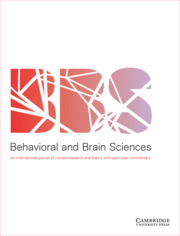Crossref Citations
This article has been cited by the following publications. This list is generated based on data provided by Crossref.
Petro, Lucy S.
Smith, Fraser W.
Schyns, Philippe G.
and
Muckli, Lars
2013.
Decoding face categories in diagnostic subregions of primary visual cortex.
European Journal of Neuroscience,
Vol. 37,
Issue. 7,
p.
1130.
Fishman, Yonatan I.
2014.
The Mechanisms and Meaning of the Mismatch Negativity.
Brain Topography,
Vol. 27,
Issue. 4,
p.
500.
Smith, Fraser W.
and
Goodale, Melvyn A.
2015.
Decoding Visual Object Categories in Early Somatosensory Cortex.
Cerebral Cortex,
Vol. 25,
Issue. 4,
p.
1020.
Thornton, Chris
2017.
Predictive processing simplified: The infotropic machine.
Brain and Cognition,
Vol. 112,
Issue. ,
p.
13.
Greening, Steven G.
Mitchell, Derek G.V.
and
Smith, Fraser W.
2018.
Spatially generalizable representations of facial expressions: Decoding across partial face samples.
Cortex,
Vol. 101,
Issue. ,
p.
31.
Huang, Yingying
Pollick, Frank
Liu, Ming
and
Zhang, Delong
2023.
Gabor and Non-Gabor Neural Representations Are Shared between Visual Perception and Mental Imagery.
Journal of Cognitive Neuroscience,
Vol. 35,
Issue. 6,
p.
1045.
Lempel, Augusto Abel
Trägenap, Sigrid
Tepohl, Clara
Kaschube, Matthias
and
Fitzpatrick, David
2025.
Development of coherent cortical responses reflects increased discriminability of feedforward inputs and their alignment with recurrent circuits.
Neuron,
Vol. 113,
Issue. 22,
p.
3834.


Target article
Whatever next? Predictive brains, situated agents, and the future of cognitive science
Related commentaries (30)
Action-oriented predictive processing and the neuroeconomics of sub-cognitive reward
Active inference and free energy
Affect and non-uniform characteristics of predictive processing in musical behaviour
Applications of predictive control in neuroscience
Attention and perceptual adaptation
Attention is more than prediction precision
Backwards is the way forward: Feedback in the cortical hierarchy predicts the expected future
Bayesian animals sense ecological constraints to predict fitness and organize individually flexible reproductive decisions
Distinguishing theory from implementation in predictive coding accounts of brain function
Expecting ourselves to expect: The Bayesian brain as a projector
Extending predictive processing to the body: Emotion as interoceptive inference
God, the devil, and the details: Fleshing out the predictive processing framework
Grounding predictive coding models in empirical neuroscience research
Interactively human: Sharing time, constructing materiality
Maximal mutual information, not minimal entropy, for escaping the “Dark Room”
Neuronal inference must be local, selective, and coordinated
Perception versus action: The computations may be the same but the direction of fit differs
Personal narratives as the highest level of cognitive integration
Prediction, explanation, and the role of generative models in language processing
Predictions in the light of your own action repertoire as a general computational principle
Schizophrenia-related phenomena that challenge prediction error as the basis of cognitive functioning
Skull-bound perception and precision optimization through culture
Sparse coding and challenges for Bayesian models of the brain
The brain is not an isolated “black box,” nor is its goal to become one
The problem with brain GUTs: Conflation of different senses of “prediction” threatens metaphysical disaster
Two kinds of theory-laden cognitive processes: Distinguishing intransigence from dogmatism
Unraveling the mind
What else can brains do?
When the predictive brain gets it really wrong
Whenever next: Hierarchical timing of perception and action
Author response
Are we predictive engines? Perils, prospects, and the puzzle of the porous perceiver